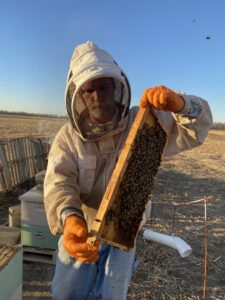Project Overview
Information Products
Commodities
- Animals: bees
Practices
- Crop Production: beekeeping
- Education and Training: study circle
Proposal summary:
Beekeeping in rural Kansas is challenging, because much of the landscape is planted in wheat, sorghum, corn, and pasture grasses which do not provide nectar or quality pollen for honeybees. Also very few plants flower in July and August, creating a “dearth” in pollinator food which reduces honey production during the summer months. Many people try to keep bees to increase bees and pollination services, but that’s only one small part of the equation. We need to find good pollinator crops that support bees, especially during the dearth, and we need to educate Kansas citizens on how to care for their bees and plant good flowering plants for bees.
Project objectives from proposal:
At AJ Honey Farms we are passionate about planting perennial native plants and garden plants for pollinators, and placing our beehives near perennial flowers. Perennials are excellent for pollinators because they flower for a long period of time and produce nectar and pollen for bees year after year.
In 2021 we had great success with our honeybee hives that were set near fields of perennial crops planted by The Land Institute (TLI), a local nonprofit that is developing perennial grains. There are two major types of crops planted at that field, 6 acres of sainfoin and 4 acres of silflower. Sainfoin, Onybrychis viicifolia, is a perennial legume that blooms from May-June in Kansas. It’s on the list of the Xerces Society’s Top 100 Plants to plant for pollinators, and it makes very sweet honey. Silflower, Silphium integrifolium, is a native perennial sunflower being developed as an oilseeds crop that flowers June-September, during the dearth. There is not much information about its honey production, but we observed our bees feeding on the flowers. Our ten first-year hives produced 500 lb of honey, when often first year hives don’t produce any honey.
In 2022 we set out 20 more hives and began collecting data on them, with the help of Dr. Ebony Murrell at TLI. Ebony and I developed a weekly checklist to check the health of 10 hives. I did this for 10 hives at
TLI and 10 hives at a site north of Salina, where no silflower or sainfoin was planted. Between Jul 20-Oct 2 the hives at TLI produced 23% more capped supers of honey (~30 lbs. honey per super) per hive than the north Salina site. The TLI hives also produced 27.5 lbs. honey per hive between Jul-Oct, versus 19 lbs. honey per hive at the north Salina site.
For this grant, we want to do a bigger experiment where we add 10 new hives to each of our two current locations, plus 10 hives at two new locations. One location will be another TLI property where sainfoin and silflower are planted. Another one will be a pasture field west of Salina, similar to our north Salina field, where no sainfoin or silflower are planted. We also want to run DNA tests on the honey samples from our hives to see how much the bees are feeding on sainfoin and silflower.
We also want to use our new store, and the fields at TLI, to run year-round classes on beekeeping. Our classes will be hands-on and outside working with bees whenever possible. Our goal is to teach Kansas beekeepers how to maintain healthy beehives, and which perennial plants to grow for healthy bees.
Objective 1: Test the honey production of beehives located next to fields of sainfoin and silflower, versus hives located in fields without these crops.
Objective 2: Train people in sustainable, profitable beekeeping using perennial flowering plants and best beekeeping practices.
Objective 3: Share findings of the silflower experiment and our training program approach at the Kansas Honey Producers Association meeting, at regional beekeeper association meetings in the state of Kansas, and through social media.
